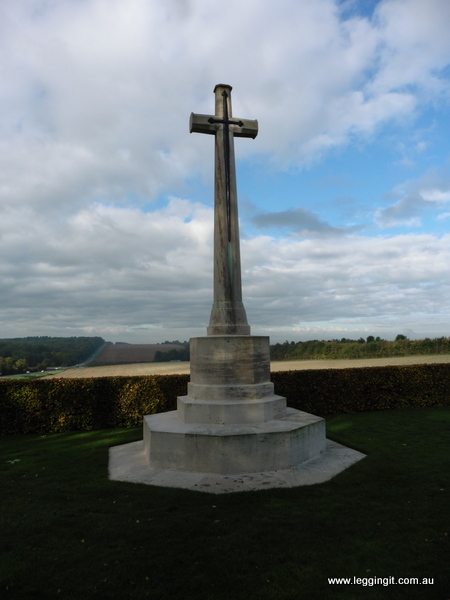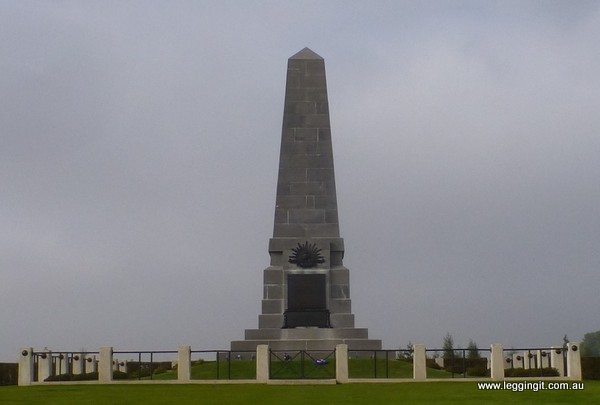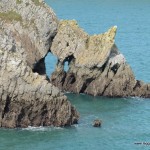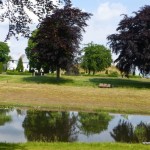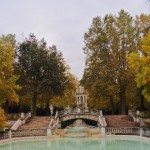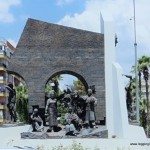We headed north from Brittany to Amiens in the Sommes area, to meet up with our friends Sandra and Val who are currently touring Europe. In the little village of Courcelles-sous-Thoix we booked the Orangery at the Chateau. It was wonderful arriving at the grand old chateau, surrounded by a moat with a drawbridge. We were quite surprised as we thundered over the drawbridge and pulled up outside. Well maybe not as surprised as the old lady at the chateau who came out to see what the noise was and saw the pair of us on a bike. The satnav had made a small error and we had arrived at the wrong Chateau. The lady explained that the other Chateau was two villages away and gave us directions in French. Her directions were spot on and soon we were arriving at the right chateau.
The Chateau was set back from the gates with a curved driveway leading to the front. After checking in we were led through a leafy path to the Orangery which was set apart from the chateau overlooking a large lawn area which was quite secluded. The Orangery was perfect for us with a loft bedroom, kitchen lounge on the ground level and wood heater. It was also only about 20 minutes to Amiens but also close to the battlefields. The little village was really peaceful apart from the occasional farmer roaring past on his tractor. On our way to town we even surprised a herd of cows who were being driven down the road after being milked. They were startled when they saw the thunderous machine and stood still all looking trying to work out what it was. I shut the bike off and hey slowly edged forward sniffing it before edging around it, they were so funny. Every time we’d pass the herd they’d all stop and look.
Villers-Bretonneux
On our first day we started with a tour which took in the town of Villers- Bretonneux, it’s one of the places synonymous with the AIF in World War One.
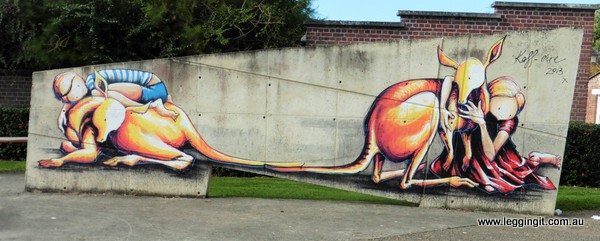
Riding around Villers-Bretonneux it’s not hard to sense the Australian flavour of the town. During the First World War Australian troops under General Monash liberated the town and the town hasn’t forgot their debt of gratitude. Shop windows proudly display Australian flags and kangaroos, the mayors building has two kangaroos either side of the French flag, and street art in Robinvale square is two kangaroos with french children. The clincher is the town symbol. The VB of Villers-Bretonneux is shaped to look like a kangaroo.
Riding into Villers-Bretonneux the first thing we noticed was that the town is twinned with Robinvale, Victoria. The town of Robinvale was named after Lieutenant George Robin Cuttle, a pilot killed in action in 1918 at Villers-Bretonneux. The name consists of Robin (the name he was known by) and Vale (to remember). His father was instrumental in renaming the town and forging links with Villers-Bretonneux.
Adelaïde Cemetery on the edge of Villers-Bretonneux is where the unknown Australian Soldier was first buried. He was exhumed in 1993 and reinterred in the chapel at the Australian War Memorial in Canberra. It’s a small cemetery which contains the bodies of not just Australian soldiers but soldiers from all over the British empire.
In the middle of town the Franco-Australian Museum currently is inside the Victoria School. The school was rebuilt after the First World War funded by donations raised in Victoria. As a reminder of the generosity the school playground has an undercover area with “Always Remember Australia” in large letters painted on the front. Also around the playground are Aboriginal style paintings and in the windows australian flags. It’s quite humbling.
At the moment the museum is housed in the school assembly hall whilst the museum is being redeveloped. The assembly hall has carved wooden Australian animals and plants around the wood panelling which ads an australian feel to the museum. The display is pretty tiny with story boards explaining the conflict, flags of the australian states, some personal effects and stories of different soldiers, along with photo displays.

Not far out of town is a large cemetery known as the National Memorial of Australia. The National Memorial of Australia was inaugurated in 1938 and honours the 11,000 Australian soldiers who died in France. It’s the site where the Dawn Service is broadcasted on ANZAC DAY. The memorial walls record all the battles the Australian soldiers fought in along with all the names and units of those who lost their lives. The memorial and graveyard which contain the bodies of not only Australians but also Canadians, British, and New Zealanders is the site where 2,100 soldiers were killed in the battle for Villers-Bretonneux. Like the Adelaide Cemetery on the other side of town it’s not the only cemetery containing the bodies of Australian soldiers. It’s just one of many, however it also commemorates those missing in action or with no known grave.
Pozieres
We decided to head towards Pozieres which was a famous Australian battlefield and along the way we stopped at the Australian 3rd Divison’s Memorial. The different divisional memorials are located where each division had a decisive battle.

Just before we reached Pozieres on the road between Albert and Pozieres we stopped at the Pozieres British Cemetery. It’s quite a decorated cemetery with wall panels recording all the names of the British dead. Like many of the cemeteries in the area there’s no shortage of Australian and other commonwealth soldiers graves.
On the edge of Pozieres is the 1st Australian Divison’s Memorial. The First Australian Division fought in this area and the memorial lies across the road from the remains of German Army pillbox nicknamed Gibraltar. During the war Pozieres was obliterated by German shelling and the remains of a farmhouse situated on the site was rebuilt into a German observation tower. Using the app (you can get it here), we learnt how the main street which runs through the town was formerly known as Dead Mans Alley. The app had lots of great and sad stories about the Australian soldiers in Poziers.
Not far away from the Australian Memorial on Pozières ridge is another Australian Battlefield known as the Windmill. The ruins of which has also been left as a memorial. All around Pozieres there are memorials to different fighting forces all basically within a 20 km radius.
Longeuval
As we were getting low on fuel we decided to head towards a more populated area and by hence we saw a sign pointing to the New Zealand Memorial, so we decided to take a detour.
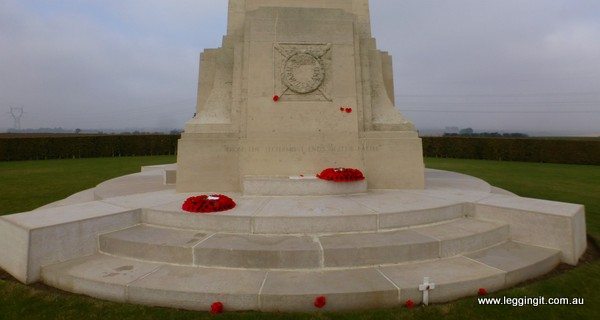
Sited on the crest of a small hill on the edge of Longeuval, the New Zealand Memorial is surrounded on all sides by farmland. When we arrived a group of blokes were standing around their Range Rovers and we took them to be French farmers. It turns out they were part of a film crew doing a doco using RC helicopters.
The NZ Memorial commemorates the area from which the New Zealand Division started their attack during the Battle of Flers-Courcelette on 15 September 1916. This was where the first tanks were used in the war. On the front of the column are the words “In Honour of the men of the New Zealand Division. First Battle of the Somme, 1916” which is also written in French on the back of the monument. The words “from the utmost ends of the earth” are also written on the monument which gives you a sense of the men the monument is dedicated to. It was a pretty moving place for Michele as her family were amongst those who came from the utmost ends of the earth to fight and die on foreign soil.
As the day was almost done we climbed back on the bike and although together on one bike we rode home alone with our thoughts. Tomorrow we lighten the mood a bit by having a day in Amiens.


